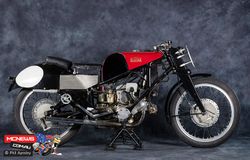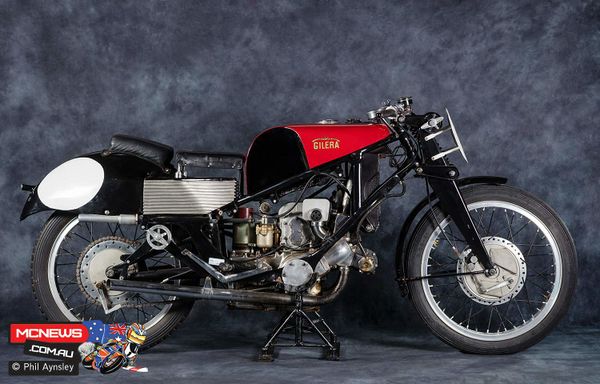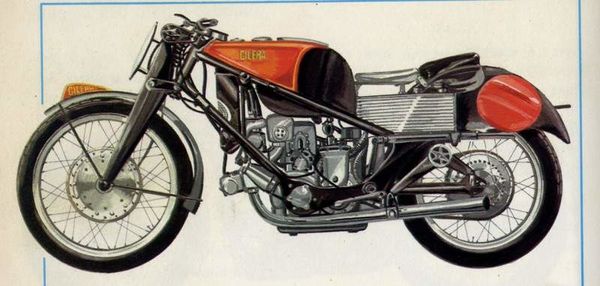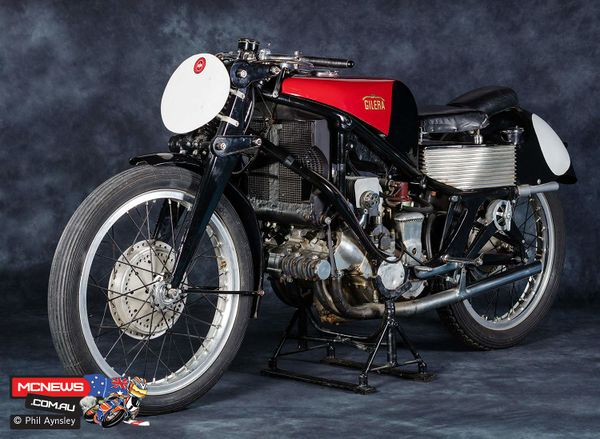Gilera 500 Supercharged
 |
|
| Racing Bikes Gilera 500 Supercharged | |
| Class | Racing |
|---|---|
| Weight | |
| Manuals | Service Manual |
Photos[edit | edit source]
Overview[edit | edit source]
Gilera 500 Supercharged 1939
1939 GILERA 5OO. Although the name Gilera did not figure in
the T.T. series until post-war days, it achieved stardom in 1939 when a
watercooled supercharged 500 c.c. four won the Ulster Grand Prix at a record
average of 97-85 m.p.h. Man on the monster was D. Serafini, and early in the
race he had a pitched battle with Walter Rusk on the supercharged watercooled
A.J.S. Vee-four (see number 4) and the "Ajay" had passed the Italian on the
straight; pulled clear, but then had to retire with a broken fork link. Rusk had
recorded the first-ever lap of the U.G.P. course at over the "ton", but Serafini
hitched the record to a new high by knocking * sec. off Rusk's best effort.
The Gilera was a complete break with traditional motorcycles;
it had pivoting-fork rear springing and a wide duplex frame that enshrouded the
radiator. The engine with sloping "pots" was built in unit with its four-speed
gearbox and supercharger and indeed looks one of the most impressive pieces of
machinery ever to see a frame. Mounting was by means of a large web in the frame
tubes which mated with each side of the crankshaft unit in line with the
crankshaft. Gear selection was by a big heel-and-toe rocking pedal.
Not only in the engine room was the Gilera unorthodox.
The rear springing units lay horizontally alongside the lower
edge of the rear mudguard and were controlled by massive friction dampers. A
full-width, deeply finned front hub was fitted to the streamlined girder forks
and the big-capacity oil tank was covered in cooling fins.
One example of this machine is preserved at the Gilera factory museum.
SPECIFICATION
Engine: watercooled in-line four-cylinder mounted transversely; 500 c.c. d.o.h.c;
supercharger driven from primary gear train.
Ignition: magneto.
Transmission: primary gear drive to four-speed gearbox,
final drive by chain. Frame: duplex cradle with pivoting-fork suspension
controlled by horizontal units and friction dampers. Forks: single-spring girder
with friction dampers.
Gilera's first four-cylinder 500 was purchased, already built and tested, from the Caproni aircraft people in Milan. They in turn had acquired it from an aircraft company in Rome. The engine of this early four-cylinder 500 was quite different from those that later powered the Gilera motorcycles. The four cylinders were sharply inclined forward (45° to the vertical) and the engine was water-cooled. Rotating-lobe supercharger feed was used and there were two exhausts, one for each pair of cylinders. The first Gilera four-cylinder was ridden by the same man who had officially driven earlier versions, Piero Taruffi. The champion rider from Milan, Giordano Aldrighetti, also drove the four-cylinder. In 1937 Taruffi rode his Gilera four-cylinder with supercharger (with overall fairing and directional fin) to set several world records. The most important of the records he broke was the flying kilometer, which he rode at 274.181 km./hr. (about 170 m.p.h.). Between 1937 and 1939 the Gilera four-cylinder was modified on the basis of racing experience. The motorcycle was well suited to all kinds of tracks, and in 1938 it won the Milan-Taranto and the Lario Circuit competitions. In 1939 Dorino Serafini won a title with the Gilera. Motorcycle: Gilera 500 Four-cylinder with Supercharger Manufacturer: Moto Gilera, Arcore Type: Racing and world records Year: 1939 Engine: Gilera four-cylinder, four-stroke, with two-shaft overhead geared distribution. Rotating-lobe supercharger. Displacement 492.7 cc. (52 mm. x 58 mm.) Cooling: Water Transmission: Four-speed block Power: 85 h.p. at 9,500 r.p.m. Maximum speed: 143 m.p.h. Chassis: Tubular double cradle, with stamped-plate parts. Front and rear, elastic suspension Brakes: Front, central drum; rear, side drum


